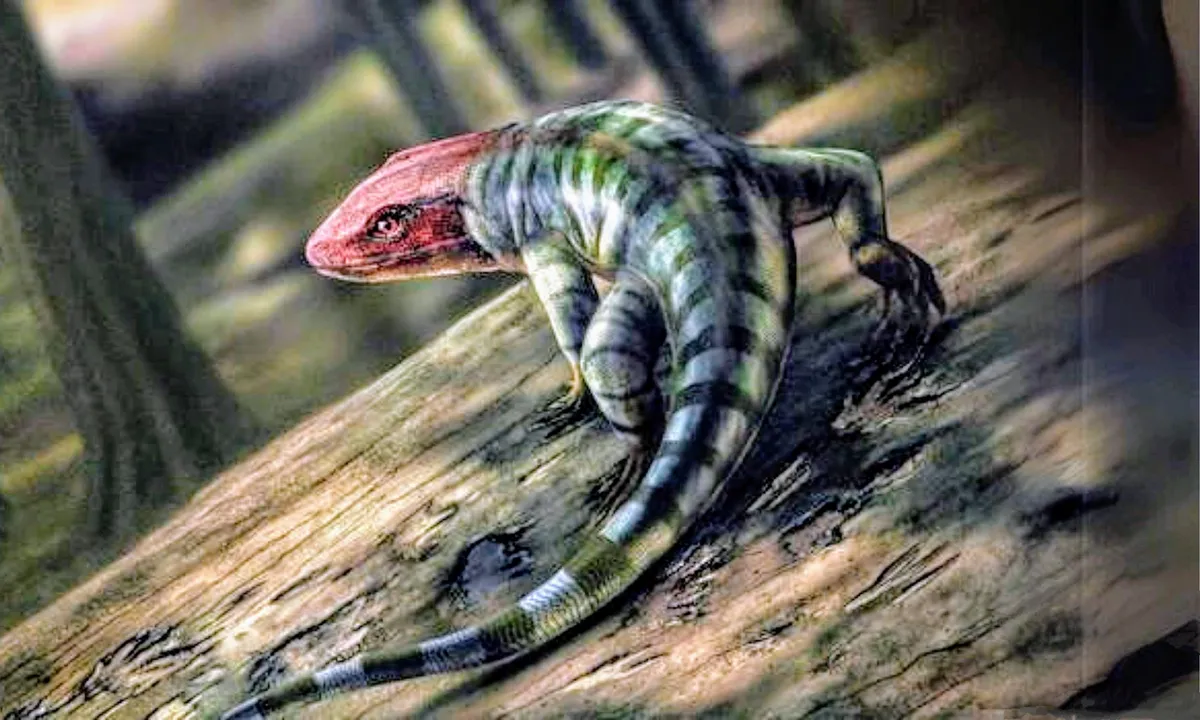
The origin of reptiles on Earth has been dramatically pushed back by an astonishing 40 million years, thanks to recent findings from fossilized tracks unearthed in Australia. This discovery presents compelling evidence that reptile-like animals existed far earlier than previously believed, challenging long-held assumptions about the evolution of tetrapods, which include amphibians, reptiles, birds, and mammals.
A research team led by Professor John Long from Flinders University has uncovered fossilized tracks of an amniote with clawed feet, dating back approximately 350 million years. These tracks, found in the Mansfield district of northern Victoria, indicate that amniotes—an important group that includes reptiles—were present during the Carboniferous period, well before established records in the Northern Hemisphere. Professor Long stated, “Once we identified this, we realized this is the oldest evidence in the world of reptile-like animals walking around on land, pushing their evolution back by 35 to 40 million years older than previous records in the Northern Hemisphere.”
The track-bearing slab discovered in Taungurung Country belongs to the Snowy Plains Formation. The creature that left these tracks likely resembled a small, stumpy Goanna-like animal, which used its clawed feet to traverse what was once part of the ancient southern supercontinent, Gondwana. Professor Long emphasized the profound implications of this discovery for the early evolution of tetrapods, suggesting that both stem-tetrapod and stem-amniote lineages began evolving in the Devonian period, much earlier than previously understood.
The fossil record of crown-group amniotes, which includes modern reptiles, birds, and mammals, was previously believed to begin in the Late Carboniferous, around 318 million years ago. Earlier estimates suggested that crown-group tetrapods emerged at 334 million years ago, with the oldest trackways dating back 353 million years. However, the newly discovered Australian tracks, securely dated to the early Tournaisian, push the origin of crown-group amniotes back by 35 to 40 million years, indicating that tetrapod evolution occurred more rapidly and earlier than previously thought. Professor Long remarked, “We now present new trackway data from Australia that falsify this widely accepted timeline.”
The sandstone slab, measuring about 50 cm across, carries the oldest known clawed footprints. Discovered by amateur palaeontologists Craig Eury and John Eason, the tracks were initially thought to belong to early amphibians. Grzegorz Niedźwiedzki of Uppsala University, a co-author of the study, noted, “When I saw this specimen for the first time, I was very surprised. After just a few seconds, I noticed that there were clearly preserved claw marks.” The presence of claws, a distinct feature of early amniotes, suggests that the trackmaker was a primitive reptile, marking the earliest known evidence of clawed feet among tetrapods.
In addition to the Australian tracks, similar trackways have been identified in Silesia, Poland. These tracks, dated to the mid-Serpukhovian to early Bashkirian, are slightly younger than the Australian finds but also display claw impressions. This discovery extends the known range of Notalacerta into the early Carboniferous, suggesting that amniotes were present across both Gondwana and Euramerica much earlier than previously believed. The Snowy Plains Formation likely dates to the early Tournaisian, approximately 358.9 to 354 million years ago, indicating that tetrapods evolved more rapidly than initially estimated.
To refine the evolutionary timeline, researchers have combined fossil evidence with DNA analysis. Molecular data offer valuable insights into the timing of evolutionary events, especially when the fossil record is incomplete. Per Ahlberg of Uppsala University explained, “It’s all about the relative length of different branches in the tree. This method helps us pinpoint evolutionary phases with a poor fossil record.” Through this approach, the team estimated the age of the tetrapod crown-group node to be in the Devonian period, coinciding with transitional ‘fishapods’ like Tiktaalik.
The Snowy Plains Formation trackway slab represents a pivotal moment in the history of life on Earth, when reptiles first set clawed feet on land. Per Ahlberg remarked, “A single track-bearing slab, which one person can lift, calls into question everything we thought we knew about when modern tetrapods evolved.” The slab, now housed in Museums Victoria, showcases a consistent foot morphology with five slender digits arranged in a fan shape, featuring claws on four digits.
Mansfield, Victoria, has long been a hotspot for fossil discoveries. Since 1980, researchers have found fossilized fish and sharks in the area, but terrestrial vertebrate tracks had remained elusive. Professor Long explained, “The Mansfield area has produced many famous fossils, beginning with spectacular fossil fishes found 120 years ago, and ancient sharks. But the holy grail that we were always looking for was evidence of land animals.” The Snowy Plains Formation trackways provide crucial evidence that reptiles and other amniotes were present in Gondwana during the early Carboniferous, challenging previous theories that limited the origin of amniotes to the Northern Hemisphere.
The discovery of clawed tracks from the early Carboniferous has significant implications for the timeline of tetrapod evolution. It suggests that the tetrapod crown-group node is located deep within the Devonian, rather than the Carboniferous as previously thought. These findings reveal that tetrapod evolution was a more rapid and complex process than recognized. The appearance of clawed amniotes in both Gondwana and Euramerica indicates that these groups may have evolved in parallel across different regions. Dr. Jillian Garvey of La Trobe University remarked, “This discovery rewrites this part of evolutionary history.”
While the Australian tracks offer valuable insights, they also raise new questions about the evolutionary history of reptiles. The fossil record in Gondwana remains incomplete, and future discoveries may further alter our understanding of when and where reptiles first emerged. Grzegorz Niedźwiedzki stated, “The most interesting discoveries are yet to come, and there is still much to be found in the field.” The Snowy Plains Formation slab serves as a powerful reminder that even a single piece of rock can reshape our understanding of the past. As researchers continue to investigate the Devonian and Carboniferous formations of Gondwana, the story of reptile evolution may undergo even more dramatic revisions.
The findings of this study have been published in the journal Nature.